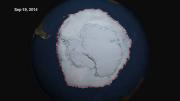Radio Program
Our regular Science and the SeaTM radio program presents marine science topics in an engaging two-minute story format. Our script writers gather ideas for the radio program from the University of Texas Marine Science Institute's researchers and from our very popular college class, Introduction to Oceanography, which we teach to hundreds of non-science majors at The University of Texas at Austin every year. Our radio programs are distributed at to commercial and public radio stations across the country.
Climate scientists are debating just how much global sea level will rise by the end of the 21st century. Projections range from less than a foot to more than six feet.
Another rapid rise in sea level took place about 8200 years ago. And the water might have come from a single source: a giant lake that stretched from present-day North Dakota and Minnesota through much of central Canada.
Thanks to El Niño, most of us know that there’s a connection between water temperatures in the Pacific Ocean and weather patterns in North America. Warmer water in the eastern Pacific produces more water vapor in the atmosphere, which produces more rain in parts of the United States.
Pacific temperatures may have a big impact in other places as well -- as far away as Antarctica. A study found that an increase in the amount of sea ice around Antarctica could be driven by conditions in the Pacific.
As its name might suggest, the lumpsucker isn’t the most attractive fish in the ocean. It’s shaped like a ball, and it has a “sucker” on its stomach that it uses to attach to rocks and kelp. Many species have lumpy, spiny skin. And they’re not great swimmers -- they lurch about with little control over where they’re going. Yet they may have a future in the cleaning business.
The northern coast of Australia looks like something is missing -- as though someone took a giant knife and carved out a square notch. But it wasn’t carved at all. Instead, it’s the result of flooding caused by rising sea levels after the last ice age.
The Gulf of Carpentaria covers about a hundred thousand square miles -- roughly the size of Colorado. At most, it’s about 250 feet deep, although most of it is much shallower.
Every year, a large “dead zone” develops where the Mississippi River empties into the Gulf of Mexico. It’s caused by a build-up of fertilizers and other nutrients that have washed down the river from farms and cities. They cause a massive bloom of algae. When the algae die, they drop to the bottom, where they’re consumed by bacteria, which use oxygen as part of the process. They use so much oxygen that there’s not enough for the fish and other organisms, which die off or move to waters that are more hospitable.
An adult blue whale can reach a length of a hundred feet and weigh up to 200 tons. That makes it the biggest animal on Earth -- not only today, but, as far as anyone knows, in the planet’s entire history.
It’s not the only giant roaming the world’s oceans, though. Several other species of whale are also enormous. But that hasn’t always been the case. In fact, a recent study found that these whales began growing so large only a few million years ago.
Ghosts haunt the oceans. They scuttle along the shore, lurk among the corals, and glide through the dark ocean depths. Some of them blend into the shimmering water so completely that they’re almost invisible. Others stare with big, dark eyes, watching every move as they slide through the water.
None of the ghosts are apparitions from the afterlife, though -- well, almost none of them. Instead, they’re fish and shellfish found around the world. But they’re called ghosts because they have some spirit-like qualities.
In late 2011, Hawaiian surfer Garrett McNamara took a thrilling ride -- or a chilling one, depending on your perspective. He surfed a wave as tall as a seven-story building. That earned him a spot in the Guinness Book of World Records. But both McNamara and another surfer say they’ve ridden even taller waves since then -- and at the same spot: near the village of Nazaré, Portugal.
Until the record-setting performance, Nazaré was little known. Since then, however, it’s become a magnet for big-time surfers and those who just want to be thrilled by the view.
Modern-day scorpions are small but creepy, and the stingers on their tails pack a painful punch. Some of their ancient relatives were also creepy, but they were big, and their tails may have packed a deadly punch.
Sea scorpions first appeared almost 470 million years ago -- one of the first big predators in the oceans. They stuck around for more than 200 million years. The first of these creepy critters lived in warm, tropical oceans and seas around the world. Later ones inhabited the oceans, marshes along the coast, freshwater lakes, and other wet environments.
A red tide can cause all kinds of problems. Neurotoxins in the microscopic organisms that cause red tides can contaminate oysters and other shellfish. Anyone who eats the shellfish can get sick, or even die. So it’s important to know when one of these harmful algal blooms is developing -- early detection can keep people from getting sick.











